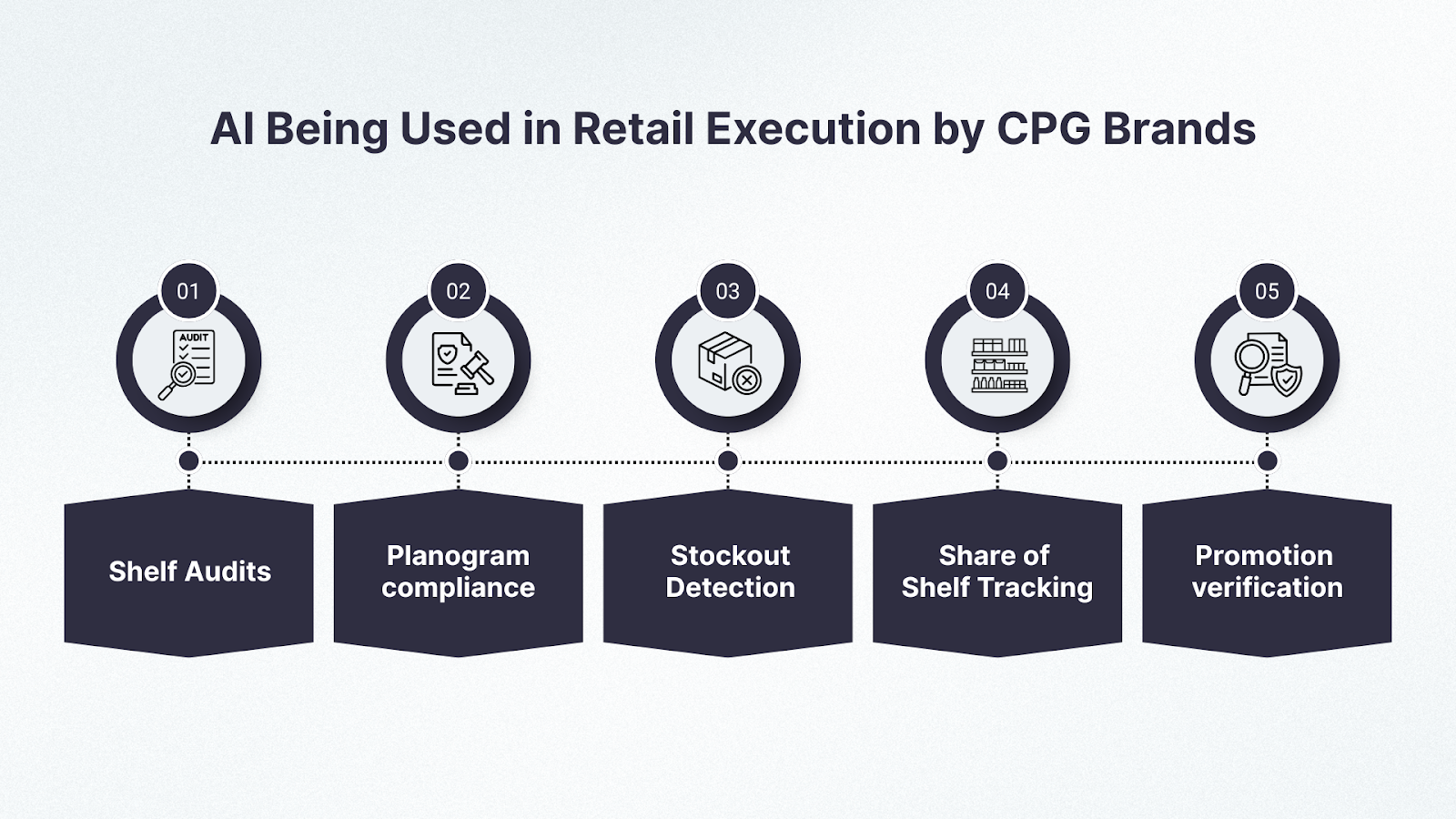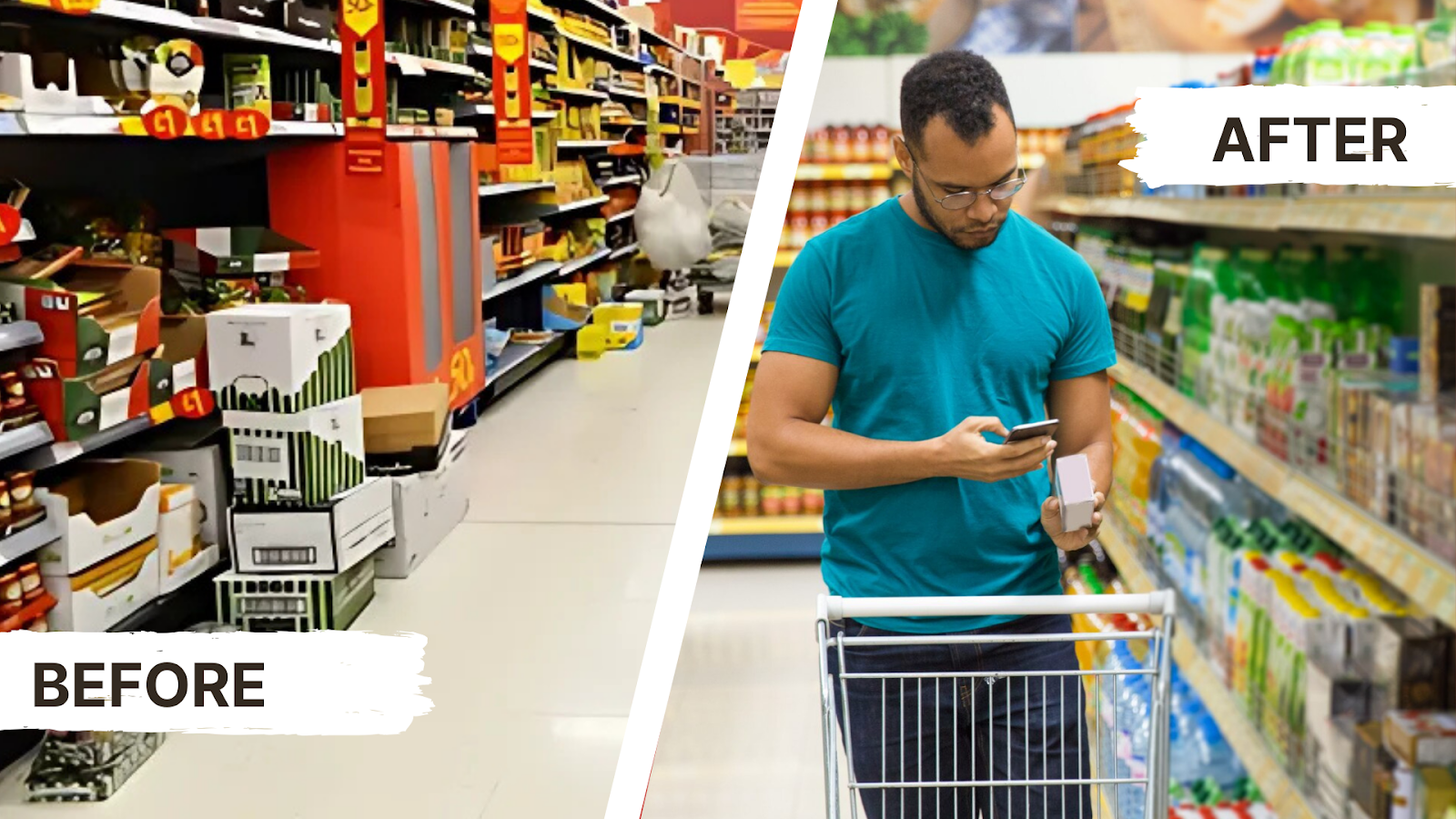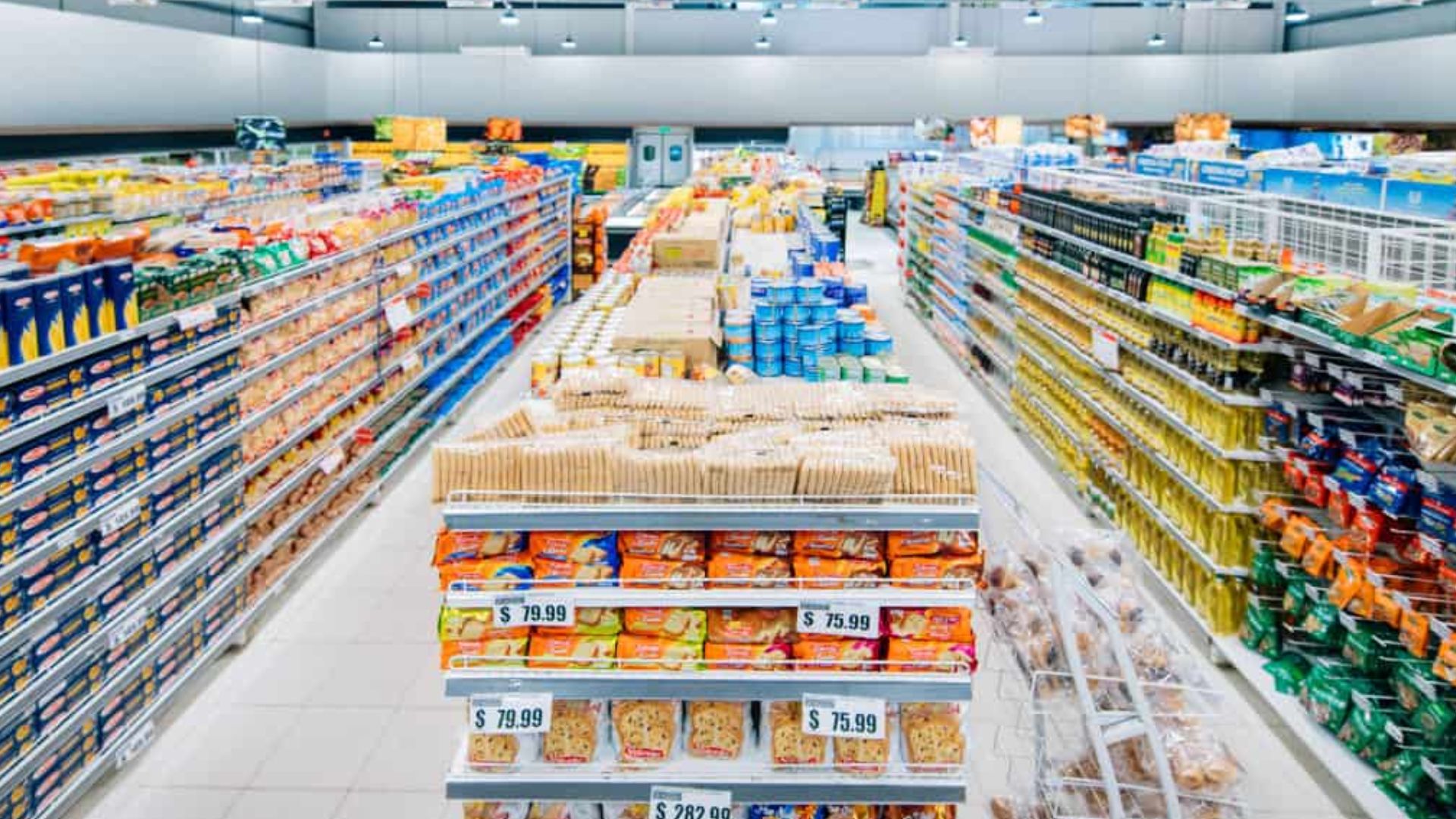A study by NVIDIA found that 69% of retail and CPG companies using AI have seen annual revenue growth, while 72% reported reduced operating costs. Yet, many CPG teams still rely on delayed, inconsistent data from offline stores. Out-of-stock SKUs, poor planogram compliance, and missed promotions continue to undermine shelf performance.
These execution gaps persist because most brands lack real-time, store-level shelf visibility. AI technologies, such as computer vision and deep learning, are now helping to close this gap. They eliminate manual audits and help CPG teams monitor on-shelf conditions more accurately and efficiently. All of these issues lead to lost sales opportunities and wasted marketing spend, further affecting profitability and brand performance.
This article explores the practical applications of artificial intelligence in the retail and consumer packaged goods (CPG) sector. We’ll also explore how AI is transforming shelf tracking, planogram compliance monitoring, and in-store execution, enabling brands to make faster and smarter decisions.
Key Takeaways
- AI helps CPG teams automate retail audits and eliminate manual errors in shelf tracking.
- Deep learning powers real-time visibility into stock levels, planogram compliance, and shelf share.
- AI-driven insights enable sales and trade teams to prioritize high-impact actions and increase coverage.
- Tools like ParallelDot’s ShelfWatch convert shelf photos into actionable, store-specific retail execution data.
Why AI Matters for CPG Execution?
CPG brands invest millions in in-store promotions, planogram planning, and merchandising campaigns. Yet, these efforts often fall short due to poor execution on the shelf. Products may be out of stock, placed incorrectly, or missing from key promotional zones, resulting in missed sales and wasted marketing spend.
The root problem is shelf visibility. Traditional audits rely on partial data from manual store visits or delayed reports. These methods cannot scale across thousands of stores or provide timely feedback. As a result, issues such as product stockouts or non-compliance often remain unnoticed for days or weeks.
AI changes this dynamic by digitizing in-store conditions at scale. With solutions like ShelfWatch, shelf images captured by field reps or merchandisers are instantly analyzed. This generates structured insights on:
- On-shelf availability: Identify exactly which SKUs are missing and where they are located.
- Planogram compliance: Identify misplacements and gaps in real time.
- Promotional execution: Verify if promotional materials are set up as planned.
This level of automation replaces guesswork with precise shelf data. It enables sales and marketing teams to act faster, resolve execution gaps quickly, and align their efforts using real-time evidence. Ultimately, AI allows CPG brands to ensure that what was planned in the boardroom is executed on the shelf.
How Is AI Being Used in Retail Execution by CPG Brands?

AI is actively solving in-store shelf execution problems faced by CPG brands, such as missing products, misplaced SKUs, and poor display compliance. For CPG teams, AI bridges the gap between strategy and execution. It turns store-level visuals into actionable insights, helping field teams identify and rectify issues on the shelf before sales are lost.
Below are some of the most impactful applications of artificial intelligence in the CPG sector today:
1. Automating Shelf Audits with Image Recognition
Field teams often rely on handwritten notes or static reports to capture store conditions. This results in inconsistent, delayed, or incomplete data.
AI transforms this process by using deep learning to analyze on-shelf photos of the product placement. When representatives capture images during store visits, AI models instantly detect:
- Missing or present SKUs
- Number of facings per SKU
- Visible pricing tags
- POS material implementation
These results are available immediately in dashboards. Sales and trade marketing teams no longer need to rely on assumptions. They get objective, store-level shelf data to improve execution on the spot.
2. Verifying Planogram Compliance at Scale
AI enables CPG teams to verify planogram compliance quickly and at scale using shelf images. It compares actual shelf layouts against approved configurations to flag misplaced, missing, or wrongly faced SKUs.
AI helps brands verify if store shelves match the approved layout. It does this by:
- Detecting if products are in the correct order.
- Checking for accurate facing counts.
- Flagging SKUs missing from assigned locations.
This automated compliance check enables faster corrections and ensures that the shelf stays aligned with brand strategy across all retail partners.
3. Identifying Stockouts in Real Time
Out-of-stock products directly impact CPG revenue. Traditional detection methods delay resolution and fail to catch issues early.
AI addresses this by scanning shelf images to identify empty facings or product stock-outs in real time. If a product is missing from its slot, the system highlights it for immediate action.
CPG Sales teams can prioritize those stores for replenishment, ensuring continuous availability and minimizing lost sales.
4. Tracking Share of Shelf for Competitive Visibility
Share of shelf determines how visible a brand is in-store compared to its competitors. Lower shelf share often translates to weaker brand recall and lost conversions for CPGs.
AI quantifies this by analyzing shelf images and calculating:
- The percentage of shelf space occupied by a CPG brand.
- SKU-level visibility compared to rival products.
Brand managers can use this data to track performance trends, identify stores with below-average market share, and support more effective trade discussions.
5. Monitoring Promotion Execution in Real Time
Trade marketing teams invest heavily in in-store promotions. But execution gaps, such as missing product displays or misplaced signage, can reduce campaign effectiveness.
AI verifies the presence of:
- Endcap and side displays.
- Shelf talkers and price boards.
- Branded POS materials.
If promo elements are missing or incorrectly placed, teams are alerted immediately. This enables fast resolution before the promotional period ends, protecting both spend and shelf impact.
These AI applications give CPG brands the shelf-level visibility they need to act faster and smarter in-store. From stockouts to planogram gaps, every execution issue becomes easier to detect, prioritize, and resolve without increasing the workload of representatives.
Also Read: How AI Image Recognition is Transforming Store Merchandising Audits in 2025
How AI Helps CPG Sales and Trade Marketing Teams?

AI is a strategic tool for CPG sales and trade marketing teams to improve in-store execution and prioritize their efforts more effectively. Real-time shelf data from solutions like ParallelDots’ ShelfWatch enables faster, data-driven actions across key areas.
- Target High-Impact Stores and Categories: Shelf-level data identifies which stores or product categories show frequent stockouts, poor shelf, or compliance issues. Instead of visiting every outlet equally, teams can focus on stores where shelf execution gaps are directly affecting sales.
- Spot Execution Failures Immediately: AI can help scan images and flag non-compliance issues, such as missing SKUs or misplaced displays, in real-time. Teams no longer need to wait weeks for manual reports. They can take corrective action the same day, reducing lost sales opportunities.
- Streamline Store Visit Planning: Execution data, when combined with sales trends, helps sales leads plan more efficient routes. Stores with persistent compliance gaps or volume potential can be prioritized for rep visits. This ensures better use of time and improves rep productivity.
- Validate Field Work with Photo Evidence: AI-powered image recognition provides visual proof of shelf conditions. Managers can review photos to ensure execution standards were met and use them to coach reps or recognize high-performing team members.
- Strengthen Data-Driven Incentive Programs: With accurate shelf-level metrics, team leaders can link representative incentives to execution quality, like planogram compliance or on-shelf availability. This encourages consistent performance and builds accountability.
With AI-powered shelf data, CPG sales and trade marketing teams can replace assumptions with actionable insights. This leads to faster execution, better prioritization, and stronger in-store outcomes.
What Challenges Are Holding Back AI Adoption in CPG?
Despite the proven benefits, many CPG brands struggle to scale AI adoption due to operational, technical, and organizational barriers. Key challenges include:
1. Fragmented and Incomplete Data Sources: AI systems rely on accurate, store-level data. But many CPG teams still operate with disconnected systems across sales, trade, and distributor functions. This fragmentation limits the reliability of insights and creates blind spots in execution.
2. Outdated Manual Processes: Without automated shelf monitoring tools, field teams still depend on spreadsheets or manual audits. These slow methods delay issue detection and prevent timely corrective action, reducing the impact of AI insights.
3. Shortage of Skilled Talent: Effective AI implementation requires trained professionals to build, manage, and refine models. Most CPG teams lack dedicated data science expertise, making it difficult to operationalize AI at scale.
4. Integration with Existing Tools: AI applications must connect smoothly with sales dashboards, CRM systems, and retail execution platforms. Integration gaps often result in isolated outputs that fail to inform day-to-day decision-making.
5. Inconsistent Model Performance: Teams need to trust that AI recommendations are reliable and repeatable. This requires constant testing, model tuning, and validation using real-world shelf data. Without it, adoption slows due to low confidence in AI outputs.
Overcoming these barriers is essential for CPG brands to fully unlock AI’s value in improving shelf execution and driving smarter in-store actions.
Also Read: AI-Powered Analytics in the CPG Industry Use Cases
How ParallelDots Can Help?
Shelf execution failures are often the result of delayed, incomplete, or inaccurate data in the store. ParallelDots helps CPG teams overcome this challenge with ShelfWatch, a deep learning-powered image recognition solution designed for fast and scalable shelf data collection in physical retail.
ShelfWatch converts in-store shelf images into accurate execution metrics, enabling CPG teams to make smarter, faster decisions. Its automation replaces manual audits with consistent, photo-based reporting at scale.
With ShelfWatch, CPG teams can:
- Monitor On-Shelf Availability in Real Time: ShelfWatch identifies missing SKUs across retail outlets by scanning shelf photos for gaps. This allows brand teams to take timely action on replenishment priorities and minimize out-of-stock losses.
- Enforce Planogram Compliance Consistently: The solution detects deviations from the intended shelf layout, ensuring consistent adherence to planogram guidelines. When planograms are not followed, ShelfWatch flags incorrect placements, helping teams course-correct and maintain display integrity.
- Quantify Share of Shelf Across Locations: ShelfWatch tracks the amount of visible shelf space each brand occupies. This lets sales and trade teams benchmark their presence against competitors and ensure fair retail execution agreements.
- Validate Promotional Compliance Instantly: CPG teams can verify if in-store promotions are executed as planned, whether the right displays, signage, or bundled packs are in place. ShelfWatch ensures that trade investments are being fully activated at the shelf.
- Integrate Seamlessly into Existing Workflows: ShelfWatch data integrates with sales dashboards, retail execution platforms, and reporting tools. This reduces duplication of effort while giving stakeholders real-time access to field insights.
ParallelDots equips CPG teams with the shelf-level visibility they need to protect availability, maintain brand standards, and drive consistent in-store performance.
Also Read: How is AI helping CPGs Optimize their Assortment Strategy
Conclusion
AI is a present-day advantage for CPG brands looking to improve in-store execution. From identifying stockouts in real time to verifying shelf compliance across thousands of outlets, AI-driven solutions offer precise, scalable insights where manual methods fall short.
But success depends on how well these technologies are tailored to real CPG challenges. Tools like ShelfWatch provide sales and marketing teams with the visibility they need to act faster, reduce missed sales, and ensure seamless store execution, all without increasing the workload of representatives.
Ready to power your retail execution with AI? Request a demo with ParallelDots to see how ShelfWatch delivers visibility, compliance, and performance in every store.
FAQs
Q1. How is AI used in CPG?
A. AI helps CPG brands track on-shelf availability, monitor planogram compliance, detect stockouts, and verify promotional execution using image recognition tools like ShelfWatch.
Q2. What are the use cases for AI in the retail industry?
A. In the CPG context, AI enables automated shelf audits, real-time tracking of stock presence, and planogram compliance verification across large retail networks.
Q3. What is the use case of AI in FMCG?
A. AI allows FMCG brands to gather store-level shelf data instantly, helping sales and marketing teams prioritize high-impact actions and correct execution gaps faster.
Q4. How does AI affect the CPG industry?
A. AI improves in-store execution by providing real-time shelf data, reducing manual audit errors, and ensuring visibility into stock, display, and promotion performance.
Q5. How is generative AI used in retail?
A. Generative AI is less commonly applied in CPG execution. Most CPG brands focus on AI for image recognition and retail shelf monitoring rather than content generation.


